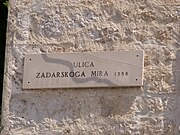
Dalmatia is one of the four historical regions of Croatia, alongside Central Croatia, Slavonia and Istria, located on the east shore of the Adriatic Sea in Croatia.

Zadar, historically known as Zara, is the oldest continuously inhabited city in Croatia. It is situated on the Adriatic Sea, at the northwestern part of Ravni Kotari region. Zadar serves as the seat of Zadar County and of the wider northern Dalmatian region. The city proper covers 25 km2 (9.7 sq mi) with a population of 75,082 in 2011, making it the second-largest city of the region of Dalmatia and the fifth-largest city in the country.

Stephen Tvrtko I was the first king of Bosnia. A member of the House of Kotromanić, he succeeded his uncle Stephen II as the ban of Bosnia in 1353. As he was a minor at the time, Tvrtko's father, Vladislav, briefly ruled as regent, followed by Tvrtko's mother, Jelena. Early in his personal rule, Tvrtko quarrelled with his country's Roman Catholic clergy but later enjoyed cordial relations with all the religious communities in his realm. After initial difficulties – the loss of large parts of Bosnia to his overlord, King Louis I of Hungary, and being briefly deposed by his magnates – Tvrtko's power grew considerably. He conquered some remnants of the neighbouring Serbian Empire in 1373, after the death of its last ruler and his distant relative, Uroš the Weak. In 1377, he had himself crowned king of Bosnia and Serbia, claiming to be the heir of Serbia's extinct Nemanjić dynasty.
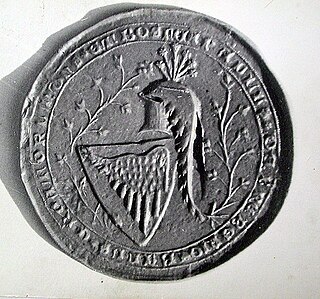
The Šubić family, also known initially as Bribirščić, was one of the Twelve noble tribes of Croatia and a great noble house which constituted Croatian statehood in the Middle Ages. They held the county of Bribir (Varvaria) in inland Dalmatia. They with their prominent branch Zrinski (1347–1703) were arguably the leading noble family of Croatia for almost 500 years.

The Kingdom of Croatia entered a personal union with the Kingdom of Hungary in 1102, after a period of rule of kings from the Trpimirović and Svetoslavić dynasties and a succession crisis following the death of king Demetrius Zvonimir. With the coronation of King Coloman of Hungary as "King of Croatia and Dalmatia" in 1102 in Biograd, the realm passed to the Árpád dynasty until 1301, when the (male) line of the dynasty died out. Then, kings from the Capetian House of Anjou, who were also cognatic descendants of the Árpád kings, ruled the kingdoms. Later centuries were characterized by conflicts with the Mongols, who sacked Zagreb in 1242, competition with Venice for control over Dalmatian coastal cities, and internal warfare among Croatian nobility. Various individuals emerged during the period, such as Paul I Šubić of Bribir, who was representing the most powerful Croatian dynasty at the time, the Šubić noble family. These powerful individuals were on occasion able to de facto secure great deal of independence for their fiefdoms. The Ottoman incursion into Europe in the 16th century significantly reduced Croatian territories and left the country weak and divided. After the death of Louis II in 1526 during the Battle of Mohács and a brief period of dynastic dispute, both crowns passed to the Austrian House of Habsburg, and the realms became part of the Habsburg monarchy.

The Kingdom of Dalmatia was a crown land of the Austrian Empire (1815–1867) and the Cisleithanian half of Austria-Hungary (1867–1918). It encompassed the entirety of the region of Dalmatia, with its capital at Zadar.
The History of Dalmatia concerns the history of the area that covers eastern coast of the Adriatic Sea and its inland regions, from the 2nd century BC up to the present day.

The Republic of Ragusa was an aristocratic maritime republic centered on the city of Dubrovnik in South Dalmatia that carried that name from 1358 until 1808. It reached its commercial peak in the 15th and the 16th centuries, before being conquered by Napoleon's French Empire and formally annexed by the Napoleonic Kingdom of Italy in 1808. It had a population of about 30,000 people, of whom 5,000 lived within the city walls. Its motto was "Non bene pro toto libertas venditur auro", a Latin phrase which can be translated as "Liberty is not well sold for all the gold".
Paul I Šubić of Bribir was Ban of Croatia between 1275 and 1312, and Lord of Bosnia from 1299 to 1312. As the oldest son of Stephen II of the Šubić noble family, he inherited the title of count of Bribir. He was appointed ban in 1273. He was relieved from duty in 1274, following his involvement in disputes between the Dalmatian coastal cities of Trogir and Split, and was returned to office in 1275.
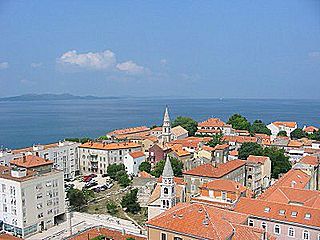
Dalmatian Italians are the historical Italian national minority living in the region of Dalmatia, now part of Croatia and Montenegro.

Giovanni Dolfin, also known as Giovanni Delfino or Delfin, was the 57th Doge of Venice from his appointment on 13 August 1356 to his death in 1361. Despite his value as a general, during his reign Venice lost Dalmatia. He was blinded in one eye after a wound received in battle.

Mladen II Šubić of Bribir, a Croatian leader and member of the Šubić noble family, was a Ban of Croatia and Lord of all of Bosnia. After succeeding his father Paul, he further consolidated the Šubić domain, and brought Stephen Kotromanić to administer Bosnia under his overlordship. His subsequent rule marked the weakening of the Šubić and ended with a mutiny of Dalmatian cities and Croatian nobility in 1322. This further led to Mladen's defeat at the Battle of Bliska and subsequent imprisonment by king Charles I of Hungary, whom the Šubićs had previously initiated and guided to take the throne. Mladen continued to develop the state and court institutions, and his de facto rule led to the further development of the chivalric culture in Croatia.
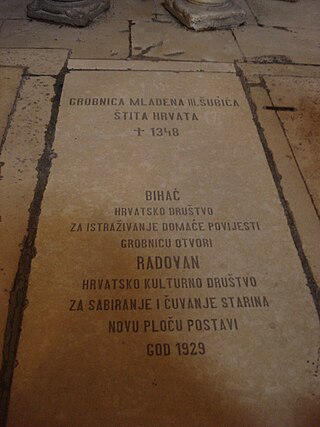
Mladen III Šubić was a member of the Croatian Šubić noble family, who ruled from Klis Fortress. He was in possession of Klis, Omiš and Skradin. He is also known as Shield of the Croats, according to the Latin epitaph in verse on his grave in Trogir.

The Theme of Dalmatia was a Byzantine theme on the eastern coast of the Adriatic Sea in Southeastern Europe, headquartered at Jadera.
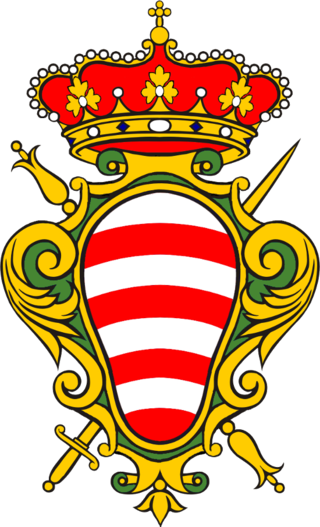
The Coat of arms of Dubrovnik was the heraldic symbol of the historical Republic of Ragusa. It is today used in a variant for the city of Dubrovnik, Croatia. Its basic appearance is based on the coat of arms of the Árpád dynasty.

Ostrovica Fortress is a ruined medieval fortification on a solid rock jutting from the top of the hill above the village of Ostrovica in Zadar County, Croatia. It is located between the two historical and geographical regions, Bukovica and Ravni Kotari. It was once an important stronghold, known as the "Key to the City of Zadar", as it was a key defense of the city. It was destroyed during the Ottoman–Venetian Wars in the second half of the 17th century, leaving only a few remains.
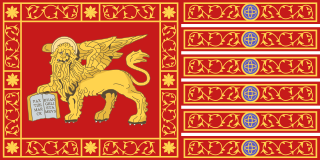
Venetian Dalmatia refers to parts of Dalmatia under the rule of the Republic of Venice, mainly from the 15th to the 18th centuries. Dalmatia was first sold to Venice in 1409 but Venetian Dalmatia was not fully consolidated until 1420. It lasted until 1797, when the Republic of Venice fell to the forces of Napoleon Bonaparte and Habsburg Austria.

Dalmatian city-states were the Dalmatian localities where the local Romance population survived the Barbarian invasions after the fall of the Western Roman Empire in the 400s CE. Eight little cities were created by indigenous inhabitants who maintained political links with the Eastern Roman Empire which defended these cities, enabling their commercial trade.

The siege of Zadar was a successful attempt of the Republic of Venice to capture Zadar, a Croatian coastal city in northern Dalmatia. It was a combined land and sea offensive by the Venetians, consisting of many separate battles and operations against the citizens of Zadar, who refused to accept Venetian suzerainty and demanded autonomy. Despite receiving military aid from Croato-Hungarian king Louis the Angevin, Zadar was unable to resist the siege and was finally defeated.
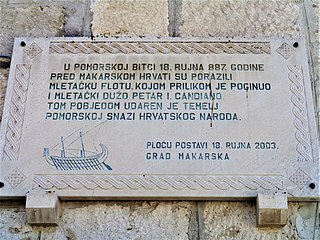
The Croatian–Venetian wars were a series of periodical, punctuated medieval conflicts and naval campaigns waged for control of the northeastern coast of the Adriatic Sea between the city-state of Venice and the Principality of Croatia, at times allied with neighbouring territories – the Principality of the Narentines and Zahumlje in the south and Istrian peninsula in the north. First struggles occurred at the very beginning of the existence of two conflict parties, they intensified in the 9th century, lessened during the 10th century, but intensified again since the beginning of the 11th century.

